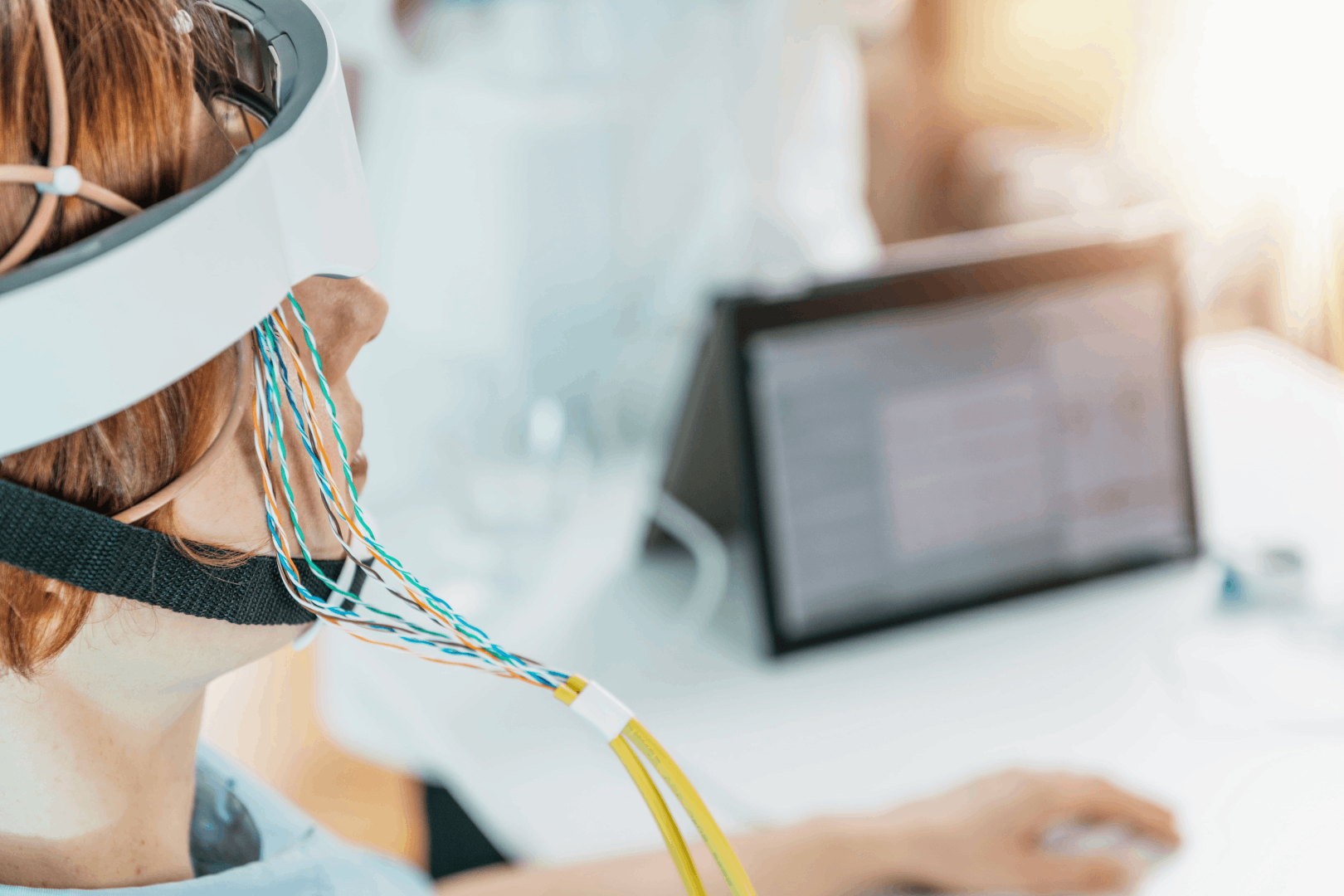Neurofeedback Session
Neurofeedback Session
What is a Neurofeedback Session?
Learn what neurofeedback is and what happens during a neurofeedback therapy session.

Article Contents
What Is Neurofeedback Therapy?
Most people know about therapy and medication to treat conditions like anxiety and depression, but few people are familiar with neurofeedback. What is neurofeedback therapy? It’s a type of therapy that changes how the brain reacts to certain stimuli. While some people may be put off by a therapy that changes the brain, it’s a non-invasive and effective treatment for several conditions.When It’s Used
What is neurofeedback therapy used for? Commonly, neurofeedback is used for people with attention-deficit/hyperactivity disorder (ADHD).1 It can also be used for conditions like insomnia, depression, and anxiety and can be particularly useful for people who have not had success with treating conditions with medication.How it Works
Neurofeedback therapy works by “training” the brain to respond in certain ways to specific triggers. It allows the individual a level of self-control over their brain functions because they learn how their brains react to triggers, and over time, they can know to respond in healthier ways. The three questions asked most about brain wave therapy are “What is neurofeedback?”, “How does neurofeedback work?” and “What does neurofeedback therapy treat?” Find out these answers and more below.How Does Neurofeedback Work?
 In a neurofeedback therapy session, the goal is to help the individual have conscious control over their brainwaves. This is done by administering a neurofeedback test and monitoring brainwaves, giving immediate feedback in audio or video responses.2
Alpha brainwaves are associated with feelings of peacefulness and relaxation, while beta waves are associated with focus, tension, alertness, and excitement. How does neurofeedback work for different conditions? Neurofeedback therapists will develop a specific treatment plan depending on an individual’s condition and needs.
If an individuals’ beta waves are being measured in a neurofeedback therapy session, therapists may use a video on a screen to demonstrate the beta brainwave fluctuations. For example, the screen will brighten when beta waves are present; when beta waves are not present, the screen will dim.
Allowing the individual to see and understand their brain’s response to stimuli helps them identify feelings and emotions that trigger specific reactions. Over time, this can help train the brain to react healthily.
In a neurofeedback therapy session, the goal is to help the individual have conscious control over their brainwaves. This is done by administering a neurofeedback test and monitoring brainwaves, giving immediate feedback in audio or video responses.2
Alpha brainwaves are associated with feelings of peacefulness and relaxation, while beta waves are associated with focus, tension, alertness, and excitement. How does neurofeedback work for different conditions? Neurofeedback therapists will develop a specific treatment plan depending on an individual’s condition and needs.
If an individuals’ beta waves are being measured in a neurofeedback therapy session, therapists may use a video on a screen to demonstrate the beta brainwave fluctuations. For example, the screen will brighten when beta waves are present; when beta waves are not present, the screen will dim.
Allowing the individual to see and understand their brain’s response to stimuli helps them identify feelings and emotions that trigger specific reactions. Over time, this can help train the brain to react healthily.
What is Neurofeedback Therapy Session Like?
It may seem intimidating if you’re not familiar with neurofeedback treatment, but it’s a straightforward and comfortable process.Set the Mood
In a typical neurofeedback therapy session, the neurofeedback therapist will ensure the individual is comfortable by communicating what the process entails. Since neurofeedback is used to regulate moods and emotions, the neurofeedback therapist will also create a safe and relaxed environment, including dimmed lights and comfortable furniture.Connect to Electrodes
Next, the neurofeedback therapist will give the individual a hat or headband to wear with electrodes connected to them. These electrodes will aid in the neurofeedback test by detecting electrical signals from the brain and transmitting them to a computer where they can be interpreted. The individual won’t feel any pain throughout the neurofeedback test, from the electrodes, or anything else.Participate in the Stimulus Activity
Once the electrodes are on, it’s time to begin the neurofeedback treatment process. Individuals will sit or lie down in a comfortable position. Each session varies from person to person, but a movie, video game, or audio is usually involved. Individuals will engage with one of these media so that the neurofeedback therapist can observe the brain’s reaction to the stimuli. A screen will darken with negative emotions throughout the neurofeedback treatment and lighten with positive emotions. This is thought to ‘train’ the brain towards positive emotions and reactions.Receive Feedback
As the brain wave therapy takes place, the individual is encouraged to stay aware of their reactions to the stimuli. Individuals who stay in tune with their reactions are more successful at training their brains toward their desired state.The amount of time and number of sessions it takes for individuals to see results varies, but many report significant improvements after two or three sessions.3
Who Benefits from Neurofeedback?
Neurofeedback treats emotional dysregulation, so if you’re facing a condition that involves emotional regulation, neurofeedback could be a good option for you. However, neurofeedback therapy is still being researched, so t’s important to research neurofeedback therapists to see if they’re qualified to treat the issues you’re looking for help with. Conditions that are commonly treated with neurofeedback therapy include:
Risks of Neurofeedback Therapy
Can neurofeedback be harmful, or worse—can neurofeedback damage your brain? While some people report side effects, those side effects are often minor and transitory, and neurofeedback is generally regarded as a safe practice. Some possible side effects of neurofeedback therapy include discomfort with the headset—though it’s not painful, it may be uncomfortable for some people—headaches, anxiety during treatment, and tiredness. However, these side effects and others can be minimized or avoided by working with a trained professional. Before any actual neurofeedback sessions, you should always be given a brain wave test or EEG biofeedback therapy test. The EEG (electroencephalograph) allows the practitioner to establish a blueprint of your brain’s electrical activity, illuminating areas of your brain with potential abnormalities and areas that need to be focused on.4 Additionally, some groups of people are more at risk of side effects. If you have a preexisting neurological condition, be sure to disclose that to your practitioner. You may experience more adverse side effects and rarer side effects that others don’t experience. People with epilepsy also should avoid this treatment; research has shown that neurofeedback therapy causes abnormal electrical brain surges that increase the likelihood of having a seizure.5Does Neurofeedback Work?
Neurofeedback can be an excellent treatment option for many people. Reported benefits include better memory, increased focus, decreased anxiety, decreased impulsivity, better sleep, and more mental clarity.6 It’s non-invasive, effective, and produces few side effects in most people. Recent studies have also revealed that neurofeedback therapy can provide long-lasting results; when the brain learns to react positively, it continues to do so even after therapy has ended.7Resources
- https://www.forbes.com/health/mind/what-is-neurofeedback-therapy/
- https://www.ncbi.nlm.nih.gov/pmc/articles/PMC4892319/
- https://www.aboutneurofeedback.com/neurofeedback-info-center/faq/when-will-i-start-to-notice-changes-from-the-neurofeedback-training/
- https://mentalhealthdaily.com/2015/07/05/neurofeedback-side-effects-adverse-reactions-dangers/
- https://mentalhealthdaily.com/2015/07/05/neurofeedback-side-effects-adverse-reactions-dangers/
- https://www.verywellmind.com/what-is-neurotherapy-22402
- https://link.springer.com/article/10.1007%2Fs00787-018-1121-4




